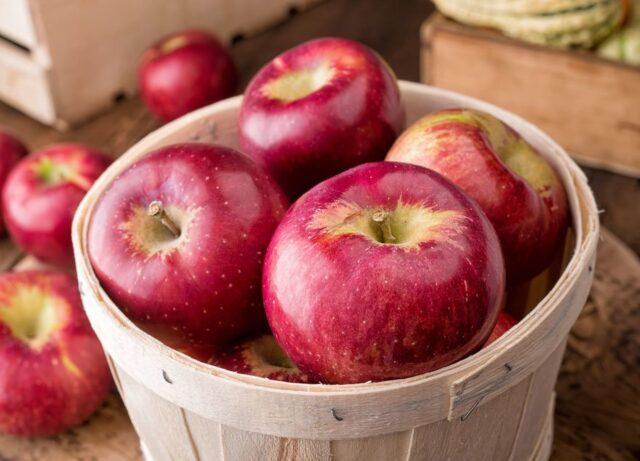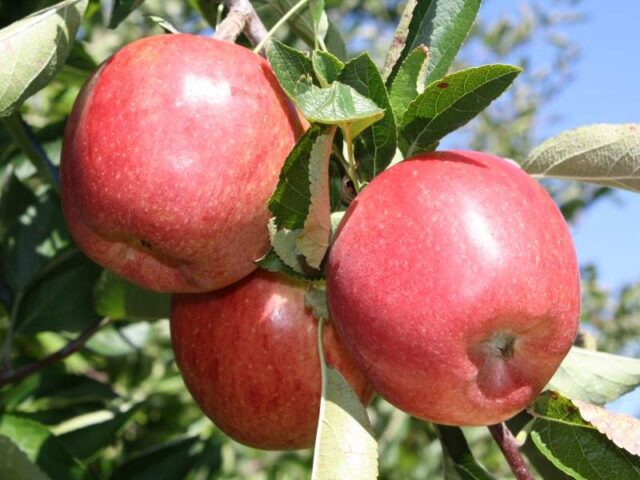Content
Black Prince apples are in high demand among consumers. After all, these fruits have a beautiful appearance, rich color, pleasant taste and are rich in beneficial components for human health. You can grow a tree that will produce such apples in your garden plot, since the Black Prince does not require complex care. And by creating favorable conditions, taking into account the characteristics of the culture, you can provide your family with these delicious fruits for the winter.

The Black Prince apple tree also has another name - Johnprince
History of selection
This variety of crop owes its origin to another common type of apple tree, namely Jonagold. The latter was bred by American breeders in the middle of the last century. Thanks to its drought resistance, excellent commercial qualities, ease of care and high yield, it quickly gained popularity among gardeners and spread throughout the world.
As a result, many breeders made attempts to clone the variety. And one of the results of this work was the Wiltons Red Jonaprince apple tree. Subsequently, another name appeared - the Black Prince.
The variety was bred in Holland in 1994. The experiment was so successful that the descendant surpassed its ancestor in some characteristics. In Russia, Black Prince has been undergoing variety testing since 2015, but has not yet been included in the State Register. Seedlings are brought from Poland and other European countries.
Description of the Black Prince apple tree with photo
The Black Prince apple tree has a number of features that set it apart from other varieties. Also, when choosing this type of crop, you should familiarize yourself with its characteristics in advance. This will allow you to determine the level of productivity of the variety and favorable growing conditions.
Wood appearance
The Black Prince is a medium-sized apple tree, up to 4 m high. The crown is round in shape. Skeletal branches extend from the trunk at right angles. The bark is smooth, gray in color. The level of foliage of the Black Prince is average. The buds are small, conical in shape.
This apple tree has young shoots that grow upright, red-brown in color, and not pubescent. The Black Prince bears fruit of a mixed type. To a greater extent, the ovary is formed on ringlets, spears, and twigs.
The Black Prince is a fast-growing crop. In the first years after planting, the growth of the apple tree per season is 60 cm. But when the tree reaches the age of five, the rate of development of the tree decreases.

It is recommended to grow the variety on a dwarf scion
Description of fruits
Black Prince apples are characterized by excellent commercial qualities, which explains the high demand of the variety among professionals and amateurs.
The fruits are round-conical, leveled, one-dimensional. The skin is medium thick, smooth. The saucer is slightly rusty, wide. The main color of the fruit is bright crimson, and with good lighting on the tree it can turn red-black.
The average weight of Black Prince apples is about 200 g. The diameter of the fruit varies within 10 cm. The pulp is juicy, moderately dense, and creamy in color. The structure of the fruit is fine-grained. When you bite, you hear a crunch.
The Black Prince's apples are sweet, with a slight sourness. The aroma is pleasant, but not intense. The fruits are characterized by an increased concentration of vitamins and antioxidants. The sugar content in the fruits of this variety reaches 8.5%.

The tasting score of the Black Prince is 4.8 points out of a possible five
Where do Black Prince apples grow?
The variety fully develops and bears fruit abundantly in the countries of Europe, North America, Canada, Ukraine, Belarus and in the central regions of Russia.
When growing the Black Prince apple tree in the southern regions, it is necessary to provide the tree with regular watering. Because with a lack of moisture, the ovary can crumble and the fruits become smaller.
Flowering and pollination
The flowers of the late apple variety Black Prince are white and pink with rounded petals, as can be seen in the photo. They have pistils and stigmas at the same level. The size of the buds when fully opened is 3 cm. The flowering period of the Black Prince begins in mid-May and lasts about ten days.

The buds on the Black Prince apple tree bloom almost simultaneously
The Black Prince is not a self-pollinating species. And for regular fruiting of this apple tree, pollinators are needed. They should be planted no further than 50 m from the tree.
The best pollinators for the Black Prince:
- Gala;
Gala is a variety that was bred in 1962
- Golden Delicious;
Golden Delicious blooms two days later than Black Prince
- Junami;
Junami is a large-fruited species bred in Switzerland
- Braeburn.
Braeburn - early fruiting apple tree
Ripening time
Black Prince belongs to the category of winter crops. Harvesting must be done no earlier than the end of September. Moreover, the peculiarity of the variety is that the fruits ripen at the same time. Experienced gardeners do not recommend harvesting ahead of schedule, as this affects the taste and shelf life.
Productivity
The Black Prince begins to bear fruit when the seedling is 3-4 years old. On a dwarf rootstock, the tree produces a yield of about 70 kg. This type of apple tree bears fruit annually.
Frost resistance
The frost resistance level of the variety is average. The tree does not suffer from temperatures dropping to -28 °C. When growing the Black Prince in the northern regions, you need to cover the tree for the winter.
Disease resistance
The variety has increased resistance to common crop diseases. But if the growing conditions are inappropriate, its immunity decreases. Therefore, preventive treatment of wood is recommended.
Advantages and disadvantages
The Black Prince, like any other strain, has strengths and weaknesses that need to be taken into account.But judging by the high popularity of this type of apple tree, there are much more of the former than the latter.

The fruits of the Black Prince have a marketable appearance throughout the entire storage period
Advantages:
- excellent taste;
- pleasant appearance;
- annual fruiting;
- non-shattering of the crop;
- amicable maturation;
- resistance to transportation;
- possibility of long-term storage;
- versatility of application.
Flaws:
- pollinators are needed;
- average frost resistance;
- need for pruning.
Landing rules
In order for the Black Prince apple tree to fully grow and bear fruit in the Moscow region and in other regions, it is necessary to plant it correctly. It is recommended to plant the variety in an open area, protected from drafts.
The Black Prince apple tree shows a high level of productivity when planted in well-drained black soil and loam. But also for the full development of the tree, a low level of acidity is required.
It is recommended to plant trees 1-2 years old. When purchasing, you should pay attention to the integrity of their bark and the condition of the root system. The Black Prince apple tree can be planted in spring and autumn, before the beginning of the growing season or at its end.
To do this, you need to prepare a hole measuring 80 by 80 cm in advance, at least two weeks in advance, so that the soil has time to settle. A drainage about 10 cm thick should be laid down the recess. And a nutritious soil mixture should be poured on top. To do this, mix turf, humus, sand, peat, leaf soil in a ratio of 2:1:1:1:1. And also add an additional 200 g of wood ash.
The Black Prince apple tree should be planted according to the standard scheme.At the end of the procedure, the root collar of the seedling should be 5 cm above the soil surface.
Features of care
After planting, you need to monitor the soil moisture, preventing the roots of the apple tree from drying out. When the seedling adapts and begins to grow, irrigation should be carried out once a month. It is recommended to water an adult apple tree during the formation of buds, at the end of flowering, during the formation of the ovary and after harvesting.
The Black Prince variety must be fertilized three times during the season. Experienced gardeners recommend starting fertilizing in the second year. In the spring, when buds open, you can use fermented mullein 1:10 or chicken manure 1:15, as well as urea 30 g per bucket of water. During flowering and fruit formation, it is necessary to use superphosphate (40-150 g) and potassium sulfate (30-100 g). And with the arrival of autumn, you need to lay a 5 cm layer of humus at the base of the apple tree.
For 2-3 years, the crown of the apple tree should be formed. The recommended number of skeletal branches for the Black Prince variety is 3-5 pcs. In addition, every season it is necessary to inspect the crown and clean it of inward growing shoots and broken branches.

The calorie content of apples of this type is 42 Kcal per 100 g of fresh product
Diseases and pests
The Black Prince variety can be affected by powdery mildew, scab, bitter rot and pitting. To prevent this, it is necessary to spray the apple tree with fungicides three times a season: in early spring, at the bud stage and after harvesting.
Among the pests that can cause damage to a tree are aphids and spider mites. And therefore, at the first signs of damage, insectoacaricides should be used.
Collection and storage
The harvest should be stored in the basement at a temperature of +3-4 ° C and a humidity of 75-80%. It is recommended to collect in the morning.Fruits should not be kept in the sun.
Apples should be placed in wooden or cardboard boxes, wrapping each one in paper so that they do not touch each other. If all conditions are met, the crop retains commercial quality for 6-8 months.
Conclusion
Black Prince apples are popular not only with adults, but also with children. After all, they have an appetizing appearance and excellent taste. Therefore, many gardeners prefer to grow this variety. After all, it is undemanding to care and bears fruit regularly.
Reviews from gardeners about the Black Prince apple tree












